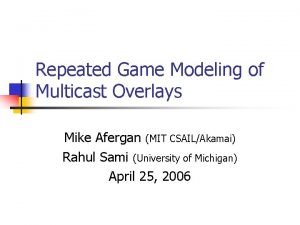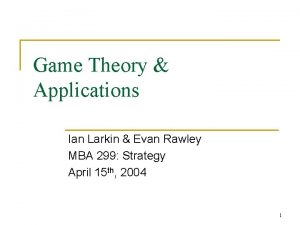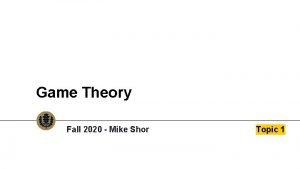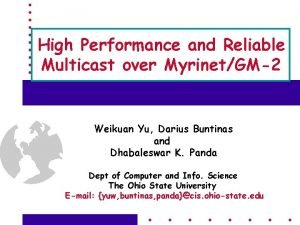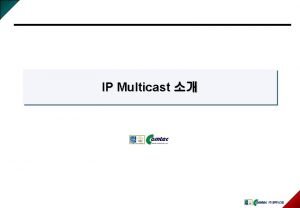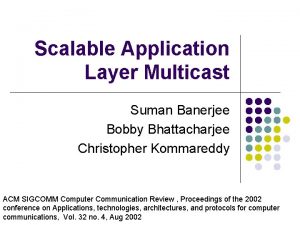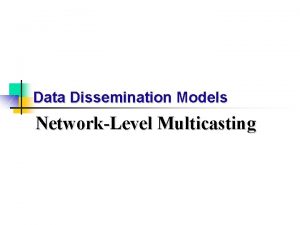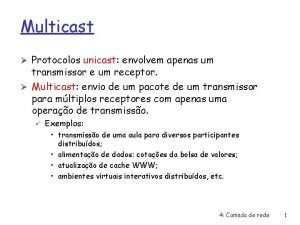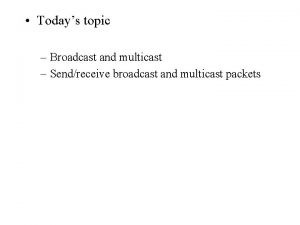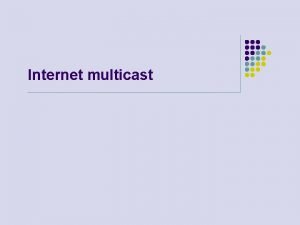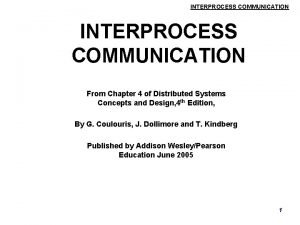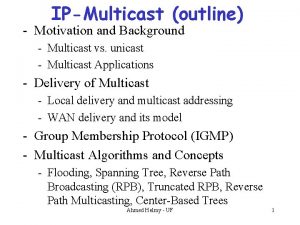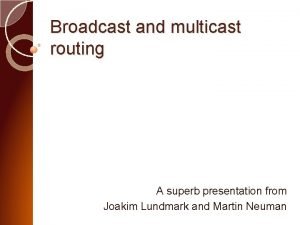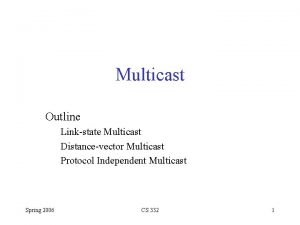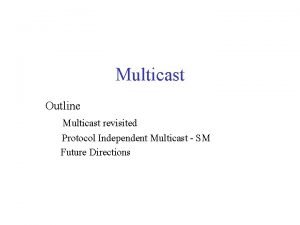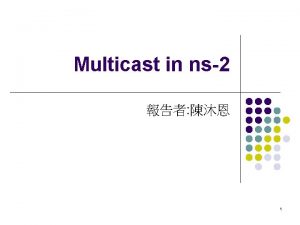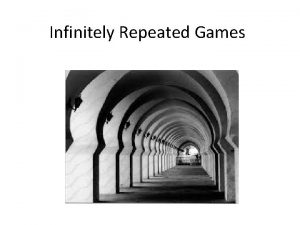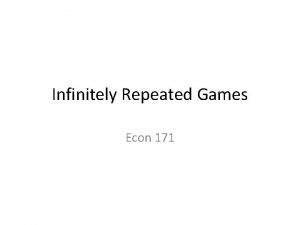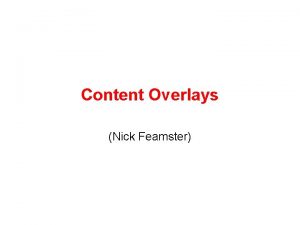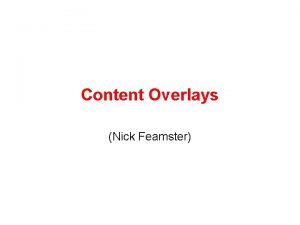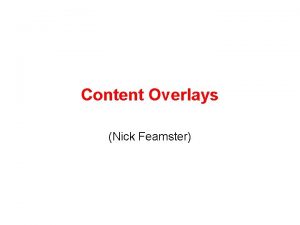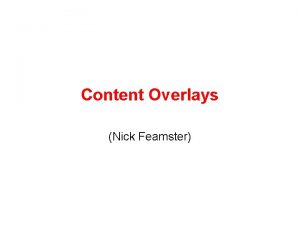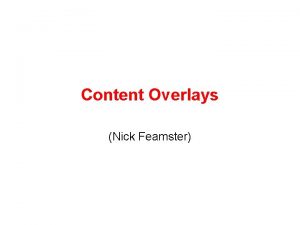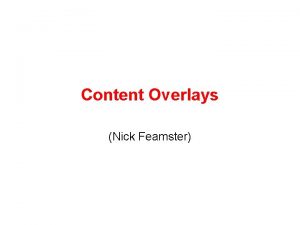Repeated Game Modeling of Multicast Overlays Mike Afergan

























- Slides: 25

Repeated Game Modeling of Multicast Overlays Mike Afergan (MIT CSAIL/Akamai) Rahul Sami (University of Michigan) April 25, 2006

Talk Overview n n n Introduction Repeated Games A Repeated Game Model of Multicast Overlays Results Summary 2

Application-Layer Multicast Want fewer children Wants to move up tree …… n n n Position in tree can impact Qo. S. [Mathay et al 04] Users have motive and means to alter tree. In the limit, becomes the unicast tree. Problem: Selfish users can degrade system performance 3

A Double Problem System Design Problem n n Goal: A protocol which creates efficient trees even with selfish users. This problem is hard: n n n Real-time and unidirectional Heavyweight solutions (e. g. , payments, complicated trees) are undesirable. NATs make many solutions (e. g. , monitoring) challenging. Modeling Problem n On a small scale, these trees exist in practice without such mechanisms. [Chu et al ’ 04] Goal: A model that explains observed behavior and provides practical insight for building robust protocols. 4

Key Insight Even selfish users want the system to exist in the future. n n Cheating degrades system efficiency and quality Can reduce lifespan of system 5

Key Contributions n A repeated model of cooperation n Cooperation is endogenous to model Does not require heavyweight mechanisms Prescriptive results for building more efficient systems 6

Talk Overview n n n Introduction Repeated Games A Repeated Game Model of Multicast Overlays Results Summary 7

One-Shot Prisoner's Dilemma P 1P 2 C D C (5, 5) (0, 9) D (9, 0) (1, 1) Static Equilibrium Outcome In the one-shot game, (D, D) is the outcome of the unique Nash Equilibrium. 8

Repeated Prisoner's Dilemma Example Strategy: 1. Play C 2. If the other player defects, play D forever P 1P 2 Outcome of the Repeated Game C D C (5, 5) (0, 9) D (9, 0) (1, 1) $$$ or $+$+$ + $+ $ +S Key Takeaway: The equilibrium of the repeated game may differ from the equilibrium of the stage game. 9

Sample Analysis P 1P 2 n n n $$$ D C (5, 5) (0, 9) D (9, 0) (1, 1) or $+$+$ + $+ $ + S Parameterized by discount factor ( ) n n C Patience Factor (infinite game) Probability of game ending (finite game with unknown horizon) Example: is an equilibrium of the RPD iff: (Playing forever) (One-time “cheat”) + (Resulting payoffs) “Play C forever. If other plays D, play D forever” is an equilibrium iff: ½ 10

Talk Overview n n n Introduction Repeated Games A Repeated Game Model of Multicast Overlays Results Summary 11

Model Intuition n n Nodes in a network form an overlay. Per time-period benefit to user dependant on: n n n Network Efficiency: n n n Quality of content received Load on user Relative network load of given tree Defines per-period probability of network continuing Selfish players maximize the (discounted) series of per-period payoffs. 12

Formal Game Model n Instance n n n Network: G = (V, E) Nodes to be served: N V Single source: s N, s V Single atomic piece of content An algorithm constructs a tree (T) which serves all nodes, N. Load of tree L(T, G) is sum of load on all links. 13

Players and Actions n User Utility Function – ui(di, ci) n n as fixed and exogenous Action Space: {Connect to Root, Drop Child, Stay} Response Function – R(L) 1. 2. 3. n Decreasing in d and c R(L(Faithful Tree)) = 1. 0 > R(L(Unicast Tree)) ≥ 0 R(L) is monotonic Equilibrium Condition: 14

Talk Overview n n n Introduction Repeated Games A Repeated Game Model of Multicast Overlays Results Summary 15

Simulator Take inputs (topology, ui(. ), N, , A) Randomly select source and N end-nodes. Each node learns di , ci, and f(L). Each node can connect to root, drop child, or take no action. 5. Repeat Step #4 until stable. 6. Collect Statistics. 1. 2. 3. 4. All datapoints represent 90 simulator runs. We prove that stable points of simulator are sub-game perfect equilibria. 16

Results Goal: A model that explains observed behavior and provides practical insight for building robust protocols. System efficiency decreases with decreasing . 2. System efficiency decreases with increasing N. 3. Specific insight for particular tree formation protocols. 1. 17

Benchmark Algorithm: Naïve Min Cost Spanning Tree n Inputs: n n n Nodes Pair-Wise distances Outputs: n Min Cost Spanning Tree Assumes all reports are truthful 18

NICE n n n (Banerjee et al ’ 02) Nodes create hierarchical tree of clusters of size k Completely distributed NICE has been shown to have good performance characteristics. [Banerjee et al, ’ 02] 19

NICE is more efficient than a Naïve Min-Cost Spanning Tree But for even mildly selfish users NICE performs better. NMC better for faithful users 20

Utility Distribution Naïve Min Cost NICE has an inherent tradeoff between depth and load. 21

Impact of Cluster Size Load Under reasonable assumptions, increasing cluster size can increase efficiency. 22

Generalizations n Core results and intuition apply to more general cases: n n Large class of utility functions Large class of response functions Noisy signal of state Noisy understanding of response function 23

Exogenous Types vs Endogenous Motivations n Prior models use exogenous types: n n Cheater/not [Mathy et al] Altruism parameter [Feldman et al ‘ 04, Chu/Zhang ‘ 04 ] A repeated game model captures these factors in an endogenous fashion. Benefits: n n Fewer degrees of freedom Behavior is dependant on the system. This enable practical conclusions. 24

Summary n n n Users have the means and motive to alter multicast overlay trees. A repeated model of interactions can explain user cooperation without heavyweight mechanisms. Behavior which is endogenous to the model enables practical conclusions. 25
 Mike afergan
Mike afergan Routing overlays
Routing overlays Overlays mmmmm
Overlays mmmmm Helen erickson biography
Helen erickson biography Relational modeling vs dimensional modeling
Relational modeling vs dimensional modeling Magiccsg
Magiccsg Game theory
Game theory David adjey
David adjey Multicast
Multicast Unicast vs multicast
Unicast vs multicast Bimodal multicast
Bimodal multicast Totally ordered multicast
Totally ordered multicast Rfp check
Rfp check Multicast
Multicast Overlay multicast
Overlay multicast Roteador
Roteador Broadcasting
Broadcasting Calico multicast
Calico multicast Unicast vs multicast
Unicast vs multicast External data representation in distributed system
External data representation in distributed system Multicast
Multicast Unicast multicast broadcast address example
Unicast multicast broadcast address example Bier multicast
Bier multicast Pengertian multicast
Pengertian multicast Broadcast and multicast routing
Broadcast and multicast routing Unicast vs multicast vs broadcast
Unicast vs multicast vs broadcast
